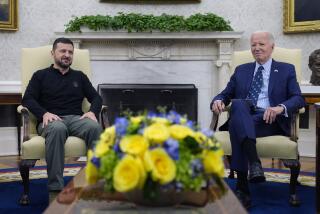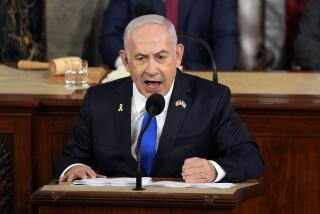U.S. arms makers look overseas as domestic demand shrinks
With the Pentagon’s appetite for new weapons shrinking, U.S. arms makers are finding lucrative markets overseas as demand for American-made weaponry hits an all-time high.
Despite intense international competition, U.S. arms manufacturers are expected to sell a record $46.1 billion in military hardware to foreign governments in 2011, a nearly 50% jump from $31.6 billion last year.
The boom is drawing fire from arms-control advocates, who worry that weapons are going to volatile regions of the world and could end up in the wrong hands.
Pentagon officials defend the sales, saying they are carefully regulated by the U.S. State and Defense departments to protect national security and are key tools in maintaining good ties with U.S. allies.
“As a country continues to strengthen its ability to defend its borders, to protect itself and, potentially, to operate with partners in the region or with the U.S. — all of that strengthens the U.S. from a security perspective,” Navy Vice Adm. William E. Landay III, who oversees foreign military sales, told reporters last week.
India signed a deal Wednesday for the purchase of 10 Boeing C-17 military cargo jets that will be built in Long Beach, highlighting the growing number of multimillion- and billion-dollar sales to foreign governments around the world.
The largest-ever U.S. foreign arms deal was announced last October, when Saudi Arabia ordered $60 billion in military hardware in a multiyear pact. The Saudis’ laundry list of weaponry included Raytheon Co.’s 2,000-pound bunker-busting bombs, Boeing’s F-15 fighter jets and Sikorsky Aircraft Corp.’s Black Hawk helicopters.
More deals are in the works. Australia wants two dozen Navy Seahawk helicopters valued at $1.6 billion. Saudi Arabia is eager to get $330 million in thermal-imaging and night-vision equipment. And Britain is looking to purchase $137 million in upgrades for its U.S.-made ship-mounted guns. Orders are also in from Morocco, Iraq and the United Arab Emirates.
Egypt is one of the largest customers for U.S. arms. But questions about its purchases were raised by critics in recent months when a column of American-made Abrams tanks rolled into Tahrir Square as protesters rallied against President Hosni Mubarak’s regime. And both Bahrain and Tunisia bought U.S.-manufactured guns before their security forces fired on protesting crowds this spring.
Jeff Abramson, deputy director of the Arms Control Assn. in Washington, points out that the U.S. loses control of a weapons system once a sale is made.
“Who knows what will happen there and whether to sell arms to the region was wise?” he said. “We’ve made decisions in the past that don’t look so good today.”
At the same time, the sales spell jobs and corporate profits in the United States. These multibillion-dollar purchases translate into years of work for thousands of highly skilled manufacturing workers and keep weapons production lines humming at a time when unemployment runs at 11.9% in California.
Before India’s order for 10 planes, Boeing’s C-17 assembly line in Long Beach was expected to shut down at the end of next year. Last week, Boeing delivered a second C-17 to the United Arab Emirates Air Force.
Workers in Long Beach will be busy mainly filling foreign orders through 2014. The sales are also good for small Southland machine shops that supply parts.
Long Beach isn’t alone in benefiting from exports. Orders from South Korea, Singapore and Saudi Arabia saved the production line of Boeing’s F-15 fighter jet in St. Louis.
Chicago-based Boeing’s pricey military and civilian airplanes together make the company the nation’s largest exporter overall. Its military sales are “a business segment that once was perceived as icing on the cake,” said Mark Kronenberg, Boeing’s vice president of international business development. “Now it’s essential.”
Foreign sales currently make up 18% of Boeing defense sales, compared with 7% six years ago, he said. The company’s defense unit has a goal of making overseas sales hit 25% within the next five years. It also plans to beef up its international sales team to 100 by the end of the year. In 2005, it numbered just 10.
Boeing booked $6 billion in foreign military sales last year, compared with $7 billion for Lockheed Martin Corp. Century City-based Northrop Grumman Corp. reported nearly $2 billion.
Since the Sept. 11 attacks, the Pentagon budget has more than doubled, to $729 billion. But now after one of the biggest military buildups in decades and amid growing concern about the federal budget deficit, defense companies are bracing for a long stretch of cuts in purchases by the U.S. government.
“Every defense contractor is looking at the international market and saying they need to be more aggressive,” Kronenberg said. “We spend hours in countries talking with everybody from military officers all the way to top leadership to see what their needs are.”
Outgoing Defense Secretary Robert M. Gates said last week that allies in the North Atlantic Treaty Organization need to spend more on defense, including weaponry. “This is no longer a hypothetical worry,” he said. “We are there today. And it is unacceptable.”
Close U.S. allies get money to help pay for the military equipment they buy. For example, Israel received an estimated $2.78 billion in U.S. aid to purchase arms. Other countries, such as Iran and China, cannot buy U.S. military hardware. Pakistan, India and Indonesia were once on that blacklist but have since been taken off. Before that, the countries purchased more arms from Russia and other European countries.
Although U.S. military technology is widely viewed as cream of the crop, it does not always win lucrative contracts overseas. In April, India announced its short list of bidders for about $10 billion in fighter jets, which bypassed American firms in favor of European ones.
France makes sought-after fighter jets. Britain is a leading tank builder, and Russia’s airplanes, cargo carriers, missiles and bombs have long been tough competition worldwide.
At next week’s Paris Air Show, one of the largest aerospace showcases, arms makers worldwide will compete to win some of the biggest foreign military deals.
The Obama administration has embarked on an initiative to reform export control that will roll back many of the restrictions on the way weapons are sold to foreign countries. Northrop, which specializes in systems such as drones and cyber security, is supporting the change, saying it will help U.S. companies win contracts.
“We have been so focused on protecting our technological edge that we have actually done severe and unnecessary damage to our defense industrial base,” Northrop Chief Executive Wesley G. Bush said at a recent conference in London.
“To the credit of President Obama’s administration,” he said, “the U.S. has finally started serious attempts to reform the laws and regulations governing our export control.”
More to Read
Sign up for Essential California
The most important California stories and recommendations in your inbox every morning.
You may occasionally receive promotional content from the Los Angeles Times.










